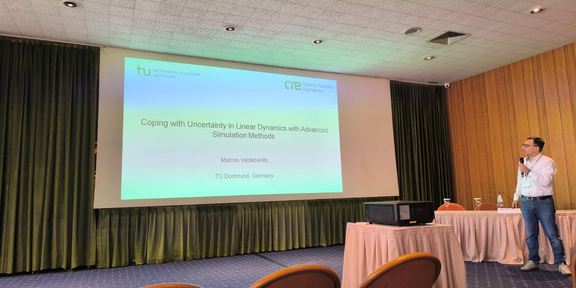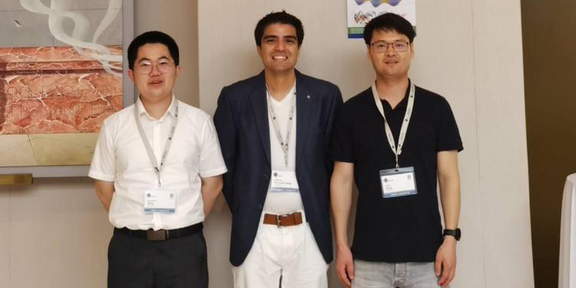News
CRE participates at COMPDYN 2025 in Greece


From June 15–18, 2025, members of the Chair for Reliability Engineering (CRE) participated in the 10th International Conference on Computational Methods in Structural Dynamics and Earthquake Engineering held in Rhodes Island, Greece. Representing CRE, Dr. Chao Dang, Cristóbal Hernán Acevedo Farías, Dr. Zhouzhou Song and Dr. Marcos Valdebenito presented their latest findings in innovative approaches in time-variant reliability, uncertainty quantification, and surrogate-based simulation techniques for dynamic systems under uncertainty.
Dr. Chao Dang Research:
Time-Variant Reliability Analysis Via A Single-Loop GPR-Based Active Learning Method
Abstract:
Time-variant reliability analysis is critical for evaluating the safety degree of engineering structures subjected to both randomness and time-varying factors. Despite its significance, conventional methods often struggle with computational inefficiency, limited accuracy, and practical applicability in real-world scenarios. This presentation will introduce a novel single-loop Gaussian process regression-based active learning (SL-GPR-AL) approach to address these challenges. The method constructs a global Gaussian process regression (GPR) surrogate model for the time-dependent performance function through an iterative active learning process. Key innovations include a tailored stopping criterion to determine when to halt the learning process and two learning functions to strategically select training points for refining the surrogate model. Once trained, the GPR surrogate enables efficient computation of the time-dependent failure probability over a reference time interval via Monte Carlo simulation, while also yielding the evolution of the failure probability over time as an additional outcome. A numerical example will be presented to demonstrate the superior computational efficiency and accuracy of the proposed method compared to several existing approaches.
Cristóbal Hernán Acevedo Farías Research:
Integrated Approach For Estimating Failure Probabilities Using Method Of Moments And Control Variates With Splitting
Abstract:
Calculating failure probabilities in engineering systems is crucial to ensure acceptable reliability levels and avoid catastrophic consequences. However, traditional methods, such as Monte Carlo Simulation (MCS), often require an excessive number of samples to estimate low failure probabilities, frequently encountered in engineering structures. This paper proposes a novel procedure that combines the strengths of two complementary methods to improve reliability estimation while reducing computational costs. The first method is the Method of Moments (MoM), which estimates failure probabilities using explicit formulas based on statistical moments of the performance function. A key task for MoM is moment estimation, which is usually conducted using a dimension reduction method. The efficiency of this method is influenced by the number of random variables, which may limit its applicability in high-dimensional problems. The second method, Control Variates with Splitting, provides unbiased estimators of statistical moments using fewer samples, improving computational efficiency. This method achieves this by leveraging information from both high- and low-fidelity models. However, Control Variates with Splitting alone is not suited for accurately calculating failure probabilities. The proposed approach exploits the advantages of both methods, focusing on moments up to the fourth order to balance efficiency and accuracy. Its performance is validated by comparing it with the traditional Method of Moments. Results demonstrate that the proposed method achieves accurate failure probability estimates with fewer samples than standard approaches, offering a practical and efficient solution to the limitations of conventional reliability analysis techniques.
Dr. Zhouzhou Song Research:
Efficient Forward And Inverse Uncertainty Quantification For Dynamical Systems Based On Dimension Reduction And Kriging Surrogate Modeling In Functional Space
Abstract:
Surrogate models are extensively employed for forward and inverse uncertainty quantification in complex, computation-intensive engineering problems. Nonetheless, constructing high-accuracy surrogate models for complex dynamical systems with limited training samples continues to be a challenge, as capturing the variability in high-dimensional dynamical system responses with a small training set is inherently difficult. This study introduces an efficient Kriging modeling framework based on functional dimension reduction (KFDR) for conducting forward and inverse uncertainty quantification in dynamical systems. By treating the responses of dynamical systems as functions of time, the proposed KFDR method first projects these responses onto a functional space spanned by a set of predefined basis functions, which can deal with noisy data by adding a roughness regularization term. A few key latent functions are then identified by solving the functional eigenequation, mapping the time-variant responses into a low-dimensional latent functional space. Subsequently, Kriging surrogate models with noise terms are constructed in the latent space. With an inverse mapping established from the latent space to the original output space, the proposed approach enables accurate and efficient predictions for dynamical systems. Finally, the surrogate model derived from KFDR is directly utilized for efficient forward and inverse uncertainty quantification of the dynamical system. Numerical examples demonstrate the proposed method’s ability to construct highly accurate surrogate models and perform uncertainty quantification for dynamical systems accurately and efficiently.
Dr. Marcos Valdebenito Semi-Plenary Lecture:
Coping with Uncertainty in Linear Dynamics with Advanced Simulation Methods
Abstract:
The aim of structural dynamics is to characterise the behaviour of structures subject to time-dependent loading. Dynamic loads (such as, e.g. wind or earthquake actions) often involve significant uncertainty. A means to account for this uncertainty consists of resorting to stochastic processes, which capture both the randomness and time-varying nature of dynamic loads. Although such an approach provides a powerful tool, it also introduces challenges for practical design. Indeed, when considering stochastic dynamic loads, the structural response becomes a stochastic process as well, requiring the uncertainty in the response to be accurately described using appropriate probabilistic descriptors. Among these descriptors, the first excursion probability is particularly useful. It quantifies the chances that structural responses exceed a prescribed threshold within the duration of the stochastic load. However, estimating this probability is challenging due to the high dimensionality of the problem (resulting from the time discretization of the stochastic load) and the time dependences. Simulation methods offer a means to cope with this challenge, because they are insensitive to the dimensionality of the problem and account for time dependences.
Within this context, this presentation examines recent advances for estimating first excursion probabilities for structural systems subjected to stochastic loads. The focus in on a particular class of problems, namely linear structural systems under Gaussian stochastic loads. Key areas of focus include:
- Reliability analysis and its sensitivity, where sensitivity refers to how the first excursion probability changes with variations in structural properties.
- Optimal design of structures subject to stochastic loading.
- Coping with epistemic uncertainty.
Conference details sourced from: COMPDYN 2025







